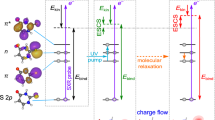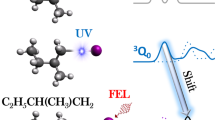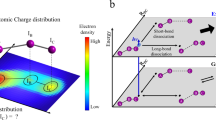Abstract
The transition state of a chemical reaction is a dividing surface on the reaction potential energy surface (PES) between reactants and products and is thus of fundamental interest in understanding chemical reactivity. The transient nature of the transition state presents challenges to its experimental characterization. Transition-state spectroscopy experiments based on negative-ion photodetachment can provide a direct probe of this region of the PES, revealing the detailed vibrational structure associated with the transition state. Here we study the F + NH3 → HF + NH2 reaction using slow photoelectron velocity-map imaging spectroscopy of cryogenically cooled FNH3− anions. Reduced-dimensionality quantum dynamical simulations performed on a global PES show excellent agreement with the experimental results, enabling the assignment of spectral structure. Our combined experimental–theoretical study reveals a manifold of vibrational Feshbach resonances in the product well of the F + NH3 PES. At higher energies, the spectra identify features attributed to resonances localized across the transition state and into the reactant complex that may impact the bimolecular reaction dynamics.

This is a preview of subscription content, access via your institution
Access options
Access Nature and 54 other Nature Portfolio journals
Get Nature+, our best-value online-access subscription
$29.99 / 30 days
cancel any time
Subscribe to this journal
Receive 12 print issues and online access
$259.00 per year
only $21.58 per issue
Buy this article
- Purchase on Springer Link
- Instant access to full article PDF
Prices may be subject to local taxes which are calculated during checkout



Similar content being viewed by others
Data availability
Data are provided with this paper and can be downloaded at https://doi.org/10.5281/zenodo.7332846. Source data are provided with this paper.
Code availability
The associated code, such as the subroutine to generate anion and neutral PESs and the quantum scattering code, is available on GitHub at https://github.com/apmtcc/AB-CDE and described in the README file.
References
Eyring, H. The activated complex in chemical reactions. J. Chem. Phys. 3, 107 (1935).
Polanyi, J. C. & Zewail, A. H. Direct observation of the transition state. Acc. Chem. Res. 28, 119–132 (1995).
Truhlar, D. G., Garrett, B. C. & Klippenstein, S. J. Current status of transition-state theory. J. Phys. Chem. 100, 12771–12800 (1996).
Guo, H. & Liu, K. Control of chemical reactivity by transition-state and beyond. Chem. Sci. 7, 3992–4003 (2016).
Zare, R. N. Laser control of chemical reactions. Science 279, 1875–1879 (1998).
Liu, K. P. Vibrational control of bimolecular reactions with methane by mode, bond and stereo selectivity. Annu. Rev. Phys. Chem. 67, 91–111 (2016).
Yang, T. G. et al. Extremely short-lived reaction resonances in Cl plus HD (v = 1) → DCl plus H due to chemical bond softening. Science 347, 60–63 (2015).
Ervin, K. M., Ho, J. & Lineberger, W. C. A study of the singlet and triplet states of Vinylidene by photoelectron spectroscopy of H2C=C−, D2C=C− and HDC=C−. Vinylidene-acetylene isomerization. J. Chem. Phys. 91, 5974 (1989).
Wenthold, P. G., Hrovat, D. A., Borden, W. T. & Lineberger, W. C. Transition-state spectroscopy of cyclooctatetraene. Science 272, 1456–1459 (1996).
DeVine, J. A. et al. Encoding of vinylidene isomerization in its anion photoelectron spectrum. Science 358, 336–339 (2017).
Metz, R. B., Weaver, A., Bradforth, S. E., Kitsopoulos, T. N. & Neumark, D. M. Probing the transition state with negative ion photodetachment: the Cl + HCl and Br + HBr reactions. J. Phys. Chem. 94, 1377–1388 (1990).
Bradforth, S. E., Arnold, D. W., Metz, R. B., Weaver, A. & Neumark, D. M. Spectroscopy of the transition state: hydrogen abstraction reactions of fluorine. J. Phys. Chem. 95, 8066–8078 (1991).
Manolopoulos, D. E. et al. The transition state of the F + H2 reaction. Science 262, 1852–1855 (1993).
Bradforth, S. E., Weaver, A., Arnold, D. W., Metz, R. B. & Neumark, D. M. Examination of the Br + HI, Cl + HI and F + HI hydrogen abstraction transfer reactions by photoelectron spectroscopy of BrHI−, ClHI− and FHI−. J. Chem. Phys. 92, 7205–7222 (1990).
Heller, E. J. The semiclassical way to molecular spectroscopy. Acc. Chem. Res. 14, 368–375 (1981).
Lorquet, A. J., Lorquet, J. C., Delwiche, J. & Hubin-Franskin, M. J. Intramolecular dynamics by photoelectron spectroscopy. I. Application to N2+, HBr+ and HCN+. J. Chem. Phys. 76, 4692–4699 (1982).
Neumark, D. M. Probing the transition state with negative ion photodetachment: experiment and theory. Phys. Chem. Chem. Phys. 7, 433–442 (2005).
Kitsopoulos, T. N., Waller, I. M., Loeser, J. G. & Neumark, D. M. High resolution threshold photodetachment spectroscopy of negative ions. Chem. Phys. Lett. 159, 300–306 (1989).
Hock, C., Kim, J. B., Weichman, M. L., Yacovitch, T. I. & Neumark, D. M. Slow photoelectron velocity-map imaging spectroscopy of cold negative ions. J. Chem. Phys. 137, 224201 (2012).
Waller, I. M., Kitsopoulos, T. N. & Neumark, D. M. Threshold photodetachment spectroscopy of the I + HI transition state region. J. Phys. Chem. 94, 2240–2242 (1990).
Kim, J. B. et al. Spectroscopic observation of resonances in the F + H2 reaction. Science 349, 510–513 (2015).
Westermann, T. et al. Resonances in the entrance channel of the elementary chemical reaction of fluorine and methane. Angew. Chem. Int. Ed. 53, 1122–1126 (2014).
Weichman, M. L. et al. Feshbach resonances in the exit channel of the F + CH3OH → HF + CH3O reaction observed using transition-state spectroscopy. Nat. Chem. 9, 950–955 (2017).
Wang, T. et al. Dynamical resonances in chemical reactions. Chem. Soc. Rev. 47, 6744–6763 (2018).
Zhang, B. L. & Liu, K. P. Imaging a reactive resonance in the Cl + CH4 reaction. J. Chem. Phys. 122, 101102 (2005).
Zhang, X., Li, L., Chen, J., Liu, S. & Zhang, D. H. Feshbach resonances in the F + H2O → HF + OH reaction. Nat. Commun. 11, 223 (2020).
Tian, L., Zhu, Y. F., Song, H. W. & Yang, M. H. Theoretical study of the F(2P) + NH3 → HF + NH2 reaction on an accurate potential energy surface: dynamics and kinetics. Phys. Chem. Chem. Phys. 21, 11385–11394 (2019).
Manocha, A. S., Setser, D. W. & Wickramaaratchi, M. A. Vibrational energy disposal in reactions of fluorine atoms with hydrides of groups III, IV and V. Chem. Phys. 76, 129–146 (1983).
Donaldson, D. J., Parsons, J., Sloan, J. J. & Stolow, A. Vibrational-energy partitioning in the reaction of F atoms with NH3 and ND3. Chem. Phys. 85, 47–62 (1984).
Wategaonkar, S. & Setser, D. W. Vibrational energy disposal in the reactions of F atoms with NH3, ND3, N2H4 and CH3ND2. J. Chem. Phys. 86, 4477–4487 (1987).
Xiao, C. F., Shen, G. L., Wang, X. Y., Fan, H. J. & Yang, X. M. Crossed beams study on the dynamics of the F-atom reaction with ammonia. J. Phys. Chem. A 114, 4520–4523 (2010).
Espinosa-Garcia, J. & Corchado, J. C. Analytical surface for the reaction with no saddle-point NH3 + F → NH2 + FH. Application of variational transition state theory. J. Phys. Chem. A 101, 7336–7344 (1997).
Espinosa-Garcia, J. & Monge-Palacios, M. Theoretical study of the F + NH3 and F + ND3 reactions: mechanism and comparison with experiment. J. Phys. Chem. A 115, 13759–13763 (2011).
Weichman, M. L., DeVine, J. A., Levine, D. S., Kim, J. B. & Neumark, D. M. Isomer-specific vibronic structure of the 9-, 1- and 2-anthracenyl radicals via slow photoelectron velocity-map imaging. Proc. Natl Acad. Sci. USA 113, 1698–1705 (2016).
DeWitt, M., Babin, M. C. & Neumark, D. M. High-resolution photoelectron spectroscopy of vibrationally excited OH−. J. Phys. Chem. A 125, 7260–7265 (2021).
Otto, R. et al. Imaging dynamics on the F + H2O → HF plus OH potential energy surfaces from wells to barriers. Science 343, 396–399 (2014).
Feng, H., Sun, W. G., Xie, Y. M. & Schaefer, H. F. Is there an entrance complex for the F + NH3 reaction? Chem. Asian J. 6, 3152–3156 (2011).
Espinosa-Garcia, J., Fernandez-Ramos, A., Suleimanov, Y. V. & Corchado, J. C. Theoretical kinetics study of the F(2P) + NH3 hydrogen abstraction reaction. J. Phys. Chem. A 118, 554–560 (2014).
Tian, L., Song, H. & Yang, M. Effects of bending excitation on the reaction dynamics of fluorine atoms with ammonia. Phys. Chem. Chem. Phys. 23, 2715–2722 (2021).
Ma, J. Y. & Guo, H. Reactive and nonreactive Feshbach resonances accessed by photodetachment of FH2O−. J. Phys. Chem. Lett. 6, 4822–4826 (2015).
Yacovitch, T. I. et al. Vibrationally resolved transition state spectroscopy of the F + H2 and F + CH4 reactions. Faraday Discuss. 157, 399–414 (2012).
Osterwalder, A., Nee, M. J., Zhou, J. & Neumark, D. M. High resolution photodetachment spectroscopy of negative ions via slow photoelectron imaging. J. Chem. Phys. 121, 6317–6322 (2004).
Neumark, D. M. Slow electron velocity-map imaging of negative ions: applications to spectroscopy and dynamics. J. Phys. Chem. A 112, 13287–13301 (2008).
Weichman, M. L. & Neumark, D. M. Slow photoelectron velocity-map imaging of cryogenically cooled anions. Annu. Rev. Phys. Chem. 69, 101–124 (2018).
Even, U., Jortner, J., Noy, D., Lavie, N. & Cossart-Magos, C. Cooling of large molecules below 1 K and He clusters formation. J. Chem. Phys. 112, 8068–8071 (2000).
Kim, J. B., Hock, C., Yacovitch, T. I. & Neumark, D. M. Slow photoelectron velocity-map imaging spectroscopy of cold thiozonide (S3−). J. Phys. Chem. A 117, 8126–8131 (2013).
Wiley, W. C. & Mclaren, I. H. Time-of-flight mass spectrometer with improved resolution. Rev. Sci. Instrum. 26, 1150–1157 (1955).
Eppink, A. T. J. B. & Parker, D. H. Velocity map imaging of ions and electrons using electrostatic lenses: application in photoelectron and photofragment ion imaging of molecular oxygen. Rev. Sci. Instrum. 68, 3477–3484 (1997).
Chandler, D. W. & Houston, P. L. Two-dimensional imaging of state-selected photodissociation products detected by multiphoton ionization. J. Chem. Phys. 87, 1445–1447 (1987).
Suits, A. G. Invited review article: photofragment imaging. Rev. Sci. Instrum. 89, 111101 (2018).
Hansen, E. W. & Law, P. L. Recursive methods for computing the Abel transform and its inverse. J. Opt. Sci. Am. A 2, 510–520 (1985).
Blondel, C., Delsart, C. & Goldfarb, F. Electron spectrometry at the µeV level and the electron affinities of Si and F. J. Phys. B At. Mol. Opt. Phys. 34, L281–L288 (2001).
Guo, H. A time-independent theory of photodissociation based on polynomial propagation. J. Chem. Phys. 108, 2466 (1998).
Knizia, G., Adler, T. B. & Werner, H. J. Simplified CCSD(T)-F12 methods: theory and benchmarks. J. Chem. Phys. 130, 054104 (2009).
Kendall, R. A., Dunning, T. H. & Harrison, R. J. Electron affinities of the first-row atoms revisited. Systematic basis sets and wave functions. J. Chem. Phys. 96, 6796–6806 (1992).
Shao, K. J., Chen, J., Zhao, Z. Q. & Zhang, D. H. Communication: fitting potential energy surfaces with fundamental invariant neural network. J. Chem. Phys. 145, 071101 (2016).
Acknowledgements
We thank the Air Force Office of Scientific Research for support via grants nos. FA9550-19-1-0051 (D.M.N.) and FA9550-22-1-0350 (H.G.). We also thank the National Natural Science Foundation of China for support under grants nos. 21973109 and 21921004 (H.S.). M.C.B. thanks the Army Research Office for a National Defense Science and Engineering Graduate fellowship. J.A.L. thanks the Alexander von Humboldt Foundation for a Feodor Lynen Research Fellowship.
Author information
Authors and Affiliations
Contributions
M.C.B., M.D. and J.A.L. performed analysis of the data collected by M.L.W. and J.B.K., with support from D.M.N. All calculations were performed and analysed by H.S. with assistance from H.G. The paper was written by M.C.B. and H.S. with assistance from H.G. and D.M.N.
Corresponding authors
Ethics declarations
Competing interests
The authors declare no competing interests.
Peer review
Peer review information
Nature Chemistry thanks Gabor Czako, Xueming Yang and the other, anonymous, reviewer(s) for their contribution to the peer review of this work.
Additional information
Publisher’s note Springer Nature remains neutral with regard to jurisdictional claims in published maps and institutional affiliations.
Supplementary information
Supplementary Information
Supplementary Discussion, Figs. 1–4, Tables 1–3 and references.
Source data
Source Data Fig. 1
Theoretical data of neutral reactive potential energy surface.
Source Data Fig. 2
Experimental and theoretical photoelectron spectra of the title reaction.
Source Data Fig. 3
Computed anion and resonance wavefunctions as well as reactive potential energy surface.
Rights and permissions
Springer Nature or its licensor (e.g. a society or other partner) holds exclusive rights to this article under a publishing agreement with the author(s) or other rightsholder(s); author self-archiving of the accepted manuscript version of this article is solely governed by the terms of such publishing agreement and applicable law.
About this article
Cite this article
Babin, M.C., DeWitt, M., Lau, J.A. et al. Observation of resonances in the transition state region of the F + NH3 reaction using anion photoelectron spectroscopy. Nat. Chem. 15, 194–199 (2023). https://doi.org/10.1038/s41557-022-01100-1
Received:
Accepted:
Published:
Issue Date:
DOI: https://doi.org/10.1038/s41557-022-01100-1
This article is cited by
-
Hairpin trimer transition state of amyloid fibril
Nature Communications (2024)



